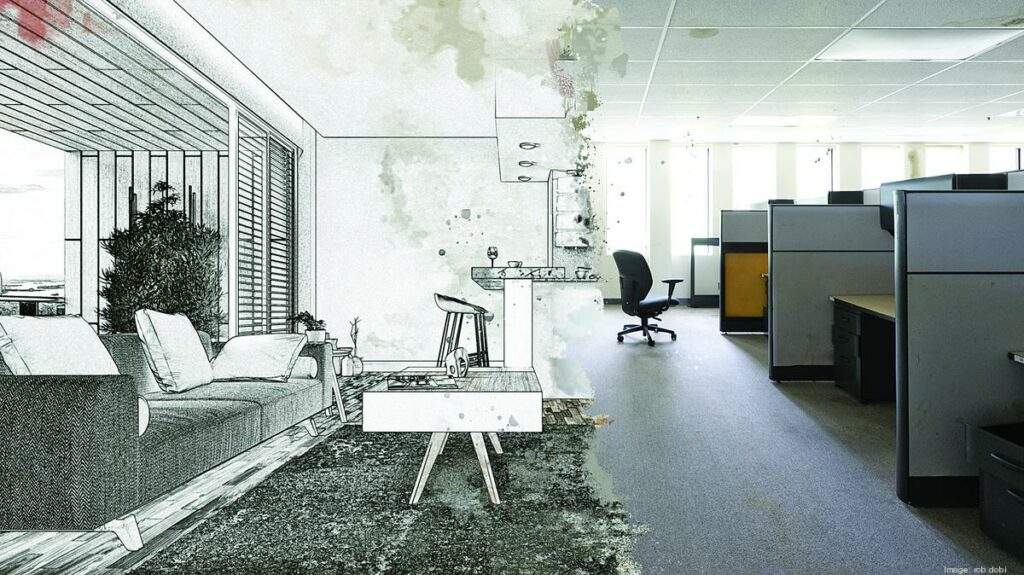According to a new RentCafe report, over the past four years, there has been extraordinary growth in the conversion of office buildings into living spaces, with an estimated 12,100 apartments crafted out of old office spaces in 2021. By 2022, that number had nearly doubled to 23,100.
The climb continued as 2023 saw an increase to 45,200, and into 2024, the pipeline has reached an impressive 55,300. That’s more than four times as great since the increasingly popular trend began.
However, new data found that behind this shift lies a crucial factor: the $150 billion in office mortgages due by 2024.
As residential space demand surges, developers are jumping on the opportunity to repurpose these aging buildings. Currently, office conversions represent a staggering 38% of the 147,000 apartments in future adaptive reuse projects, outpacing any other building type—a record high since 2020.

The office spaces that are being picked for makeovers are newer than some of the rundown edifices seen in the average major metro. On average, they are 72 years old. That’s 20 years less than the ones already converted. This suggests a strategic preference for buildings that might require less investment in refurbishment and are more likely to meet modern standards, potentially simplifying the conversion process.
But where are these conversions taking place?
This trend is most prominent in Washington, D.C., where 5,820 units are set to transition from office-to-apartment spaces, followed closely by the Big Apple—New York—with 5,215 units in the pipeline. The fourth-largest metro area in the United States, Dallas, is expected to have an estimated 3,163 units converted, reflecting an impressive 58% increase from 2022.
Top 10 Metros for Future Office-to-Apartment Conversions Underway in 2024
Popular metros like Washington, D.C., New York, Chicago, Dallas, Los Angeles, and Seattle are leading the future trend of urban redevelopment, reflecting a nationwide adoption of adaptive reuse. This movement not only adds housing but may potentially cause a shift towards more sustainable and community-focused urban environments, indicative of changing lifestyles and priorities in American cities.
- Washington, D.C. (An estimated 5,820 units expected to be converted from office to living spaces)
- New York (5,215)
- Dallas (3,163)
- Chicago (2,822)
- Los Angeles (2,442)
- Cleveland (2,012)
- Cincinnati (1,563)
- Kansas City, MO (1,510)
- Atlanta (1,422 units)
- Phoenix (1,377 units)
1. Washington, D.C.
- The Washington-Arlington-Alexandria metro area has a planned 5,820 units set to transition from office-to-apartment spaces in 2024.
- This represents a 64.5% share of the area’s total conversions and marks a staggering 88% increase compared to a year ago, underscoring a robust growth in the region’s housing solutions.
- The Fort Myers Drive project in Arlington, VA, is the standout in this transformation, aiming to repurpose an office building into 691 new homes.
2. New York, NY
- The New York-Newark-Jersey City metro is a leader in reinventing its skyline, with 5,215 units in the office-to-apartment pipeline.
- These conversions make up 45.4% of the metro’s future apartment projects, with an 18% uptick since the previous year.
- The 25 Water Street project in Manhattan epitomizes this surge. This former office building will be transformed into 1,263 new apartments.
3. Dallas, TX
- the Dallas-Fort Worth-Arlington metro is projected to develop an ambitious 82.5% of its future apartments in the pipeline, haling from office buildings, totaling 3,163 units.
- This is a notable 58% jump from last year, reflecting the area’s dynamic adaptability.
- The Renaissance Tower on Elm Street Redevelopment will contribute 500 units to the Dallas cityscape, further invigorating the local community.
Office conversions now represent approximately 38% of the 147,000 apartments in future adaptive reuse projects and the number is expected to keep increasing. In the future, will there be just as many office spaces as apartment complexes? Will remote work fuel more office-apartment-conversions?
Only time will tell.
To read the full report, including more data, charts, and methodology, click here.






